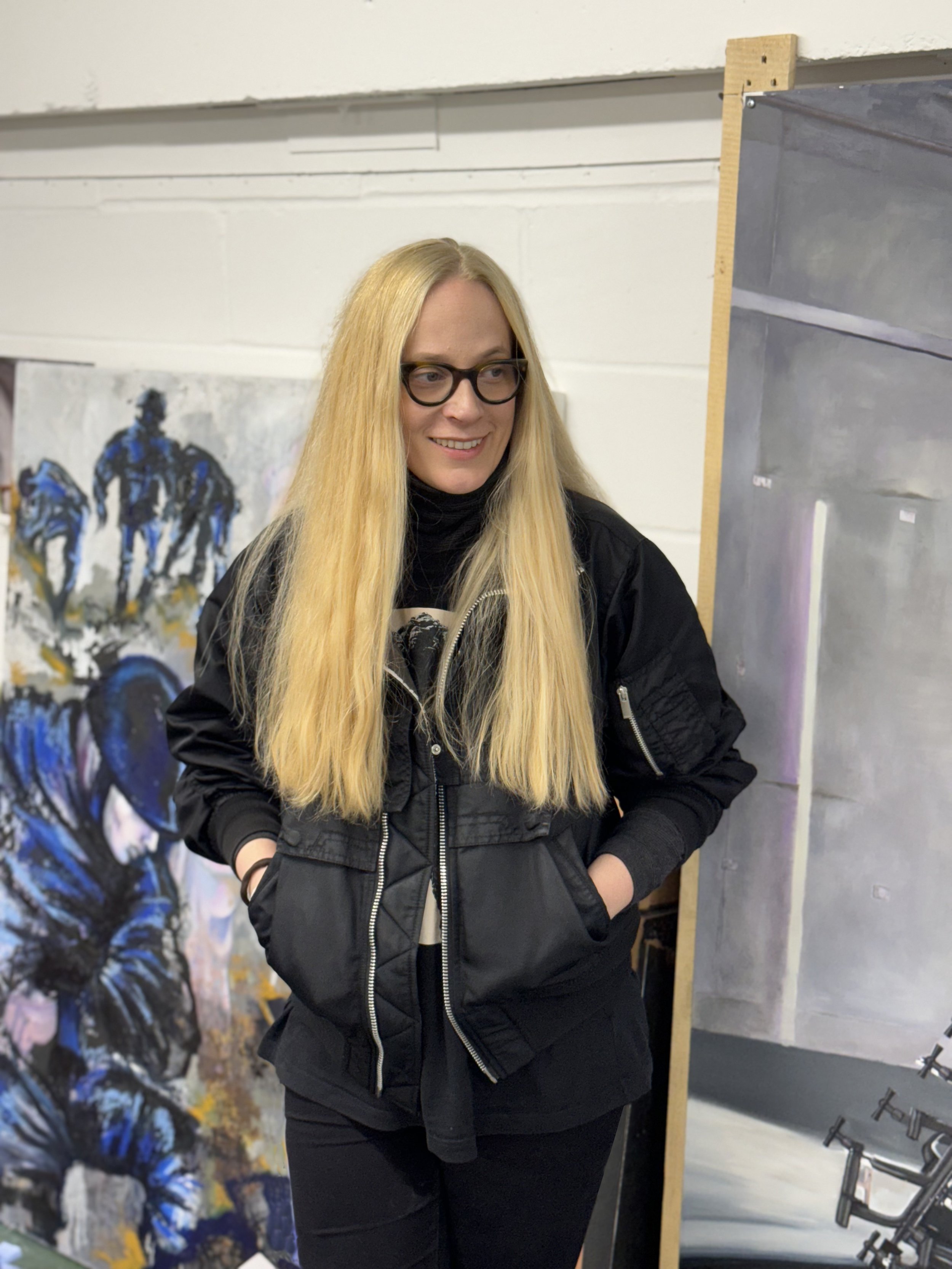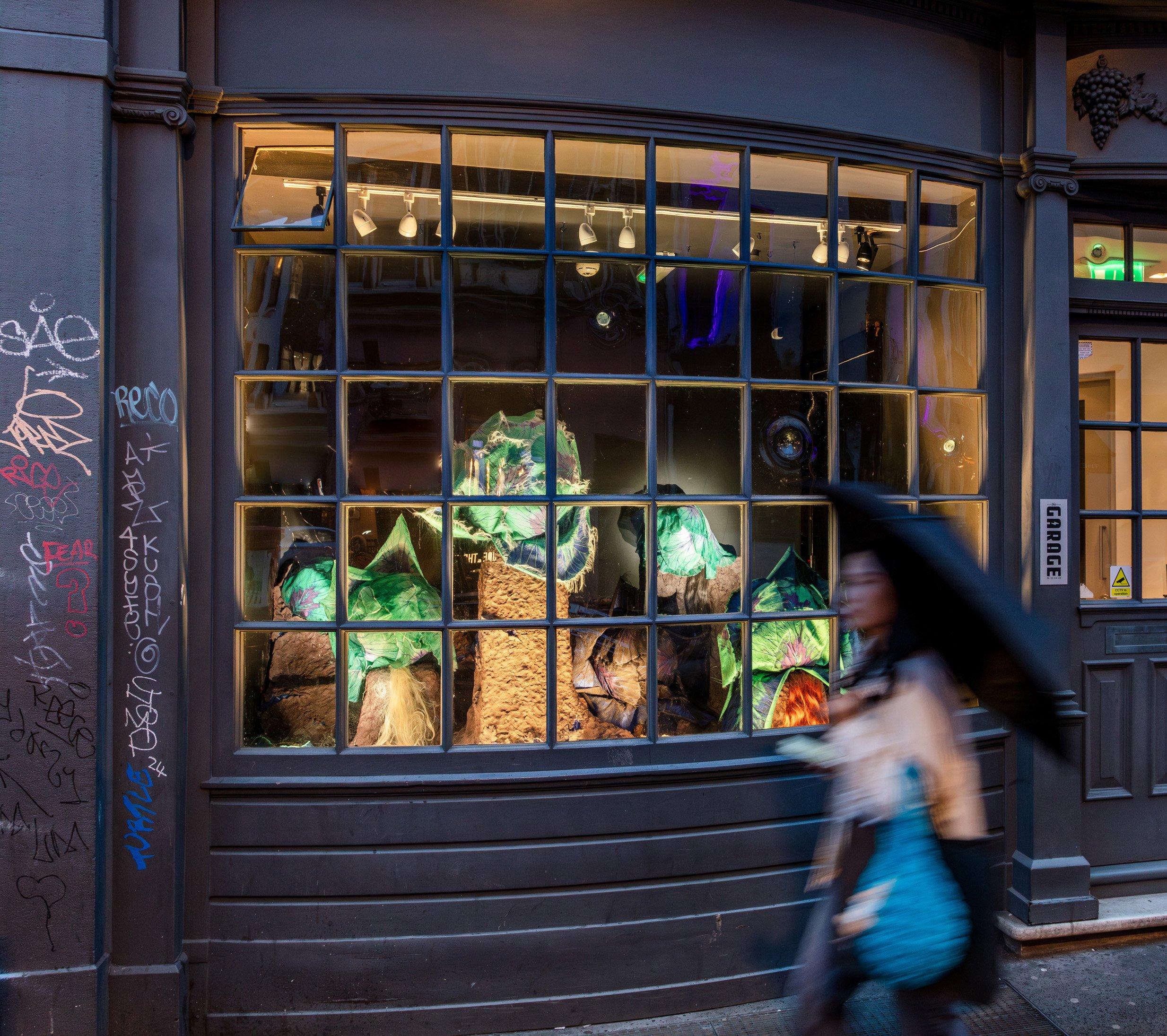Artist interview: Molly Grad
I’m standing outside No. 62 Dean Street — aka The Smallest Gallery in Soho — on a Friday morning. It’s so dark and dimly lit inside that I see more of what’s behind me than I can of whatever is behind the glass. As soon as my eyes focus on what appears to be a shimmery green leaf they’re distracted by reflections of passing businessmen and the splash of a slop bucket being emptied by a cleaner. I try to refocus on the artwork but am distracted once again by the reflection of an approaching figure.
“Happy?” I ask without turning around.
“Yeah, really happy” is her reply.
Molly Grad is an interdisciplinary artist whose practice spans sculpture, textiles, painting and public interventions. Her artist statement lists ‘seeking out hidden histories and marginalised experiences in order to explore redemptive modes of expression’ but I’ve seen her work a few times and sometimes the best way to explain what an artist is, is by explaining what an artist does.
Molly subverts materials — such as crafting ribbons out of metal or making wood look like steel — and then places them in highly visible locations where you’d least expect them to be. Bright yellow is a colour that frequently features, at least in the works I’ve seen. It draws further attention to the fact they often appear to be radically out of place. She refers to these public interventions as fleeting sculpture, saying “It’s there and then it’s gone.” They’re neither permanently placed for posterity, nor street art gambling on how long it might last. She’s commented that “people can do whatever they want… with it or to it, and only engage if they want to.” Now, however, she’s placed a public intervention safely behind glass, with limited vantage points, and that’s why we are meeting.
It’s our third of three sessions in which we are discussing her current show before, during and after the install. Now that it’s finished my first question is to ask her how she views this project within the context of her practice. “Except for being in a vitrine, it’s no different. Its there. It’s art. At some point you leave it.” Except she can’t, not yet anyway. Like a nurturing parent, who is also mother of a five year old, Molly has already returned to the site multiple times in the week after it opened to watch how people experience it.
That’s understandable. The show wasn’t something in her portfolio that was simply re-hung, but a bespoke work that was initially conceived almost eight months ago. And although there was planning and preparation Molly admits that she wasn’t really sure how it was going to turn out. She had a notion, but ultimately wanted to let the things take their form, like actors working together in a performance. And for three weeks that’s essentially what it was. I spent some time inside the space on the day she began and she commented how it was “very quiet and white and bare. It feels like you’re on your own,” even though she wasn’t. And wouldn’t be.
A core feature of The Smallest Gallery in Soho is that it facilitates discovery because it’s “in the middle of a super noisy, super ongoing part of London.” She goes on to tell me about a little boy and his mother that stopped to watch. “What are they?” the boy yelled through the glass. “They’re cabbages!” Molly yelled back. I like to think about all the people who didn’t stop to ask, or who might have passed by but never made their way back to find out. Right now a German or American tourist could be idly reminiscing about their London trip and wondering what that lady was making in that window.
Both the content and the title of the show, Cabbage Patch Kids, reference one of the most popular American toys of all time, whose introduction and vastly underestimated supply chain led to crazed parents violently clashing in their attempts to secure Christmas presents. Aside from the obvious nod towards capitalist exploitation, Molly is also fascinated by the happy coincidence that ‘cabbage’ has negative slang connotations in many languages, often meaning ‘naive’.
In her installation there’s something almost sinister about the blacked out walls and mysterious nature of the scene. It’s an incongruous mix of mud and plinth, and visually unclear if the cabbages are in the process of emerging or if they’ve already been plucked out and placed on the synthesised Earth for display. She explains the supporting structure to me in the context of modern public playgrounds, lamenting how what we call nature within the urban realm is no longer grass but a ‘layer cake’ of construction debris, architectural remains and petrochemicals. “What kind of creatures are we growing in our soil that we contaminated? Who are the kids that will grow out of the soil?”
It’s fascinating to chat with Molly. The conversation covers a wildly disparate range of topics, and yet everything somehow relates back to the installation she just finished. She explains the concept of Figura Serpentinata, a style intended to give sculptures the appearance of motion, which is an effect she aimed to achieve in the space. Rather successfully, I’d say. We then discuss two 80s movies that it reminds me of. I won’t list them since the association was purely mine, but that triggered a chat about how art takes on a life of its own once an artist generously releases it into the wild, which is often a literal aspect of her practice.
Prior to the installation, before I even knew about the cabbage patch theme, I asked Molly to send me some thoughts describing how she was feeling about the upcoming install. She wrote: “Just finished trimming leaves and fraying them. Cannot wait to see them in a confined space. Feels like they need to be in a small, unruly environment which is what I intend the install to feel.” That didn’t make sense at the time, but if you manage to visit the gallery then it’ll all become clear even though the work is ambiguous. For the full effect, I recommend a night-time visit when the space is eerily lit from within, enabling you to see additional details that will likely raise even more questions than answers.
Molly’s public interventions are typically an isolated event set amidst public uncertainty, with many elements out of her control. In lieu of those things she’s created an environment that replicates, at least symbolically, the chaos and muck of the world we live in. When we started this interview she commented that “we don’t live in easy times” and I think it’s fitting that the work she makes doesn’t provide easy answers. It’s open-ended and isn’t meant to make a definitive statement, but is visually engaging enough to draw you in so you can think up your own.
A quick disclaimer:
As a Friend of the Gallery, London Art Roundup is provided with advance and behind-the-scenes access to interview the artists that exhibit at The Smallest Gallery in Soho. All contributions are voluntary. Neither the artist, gallery or London Art Roundup received any financial compensation for this interview.
Click here to read our interview with The Smallest Gallery in Soho.
Plan your visit
‘Cabbage Patch Kids’ runs until end of June 2024.
Visit thesmallestgalleryinsoho.com and follow @thesmallestgalleryinsoho on Instagram for more info about the venue.
Visit mollygrad.com and follow @mollygrad on Instagram for more info about the artist.
PLUS…
Check the What’s On page so you don’t miss any other great shows closing soon.
Subscribe to the Weekly Newsletter. (It’s FREE!)



